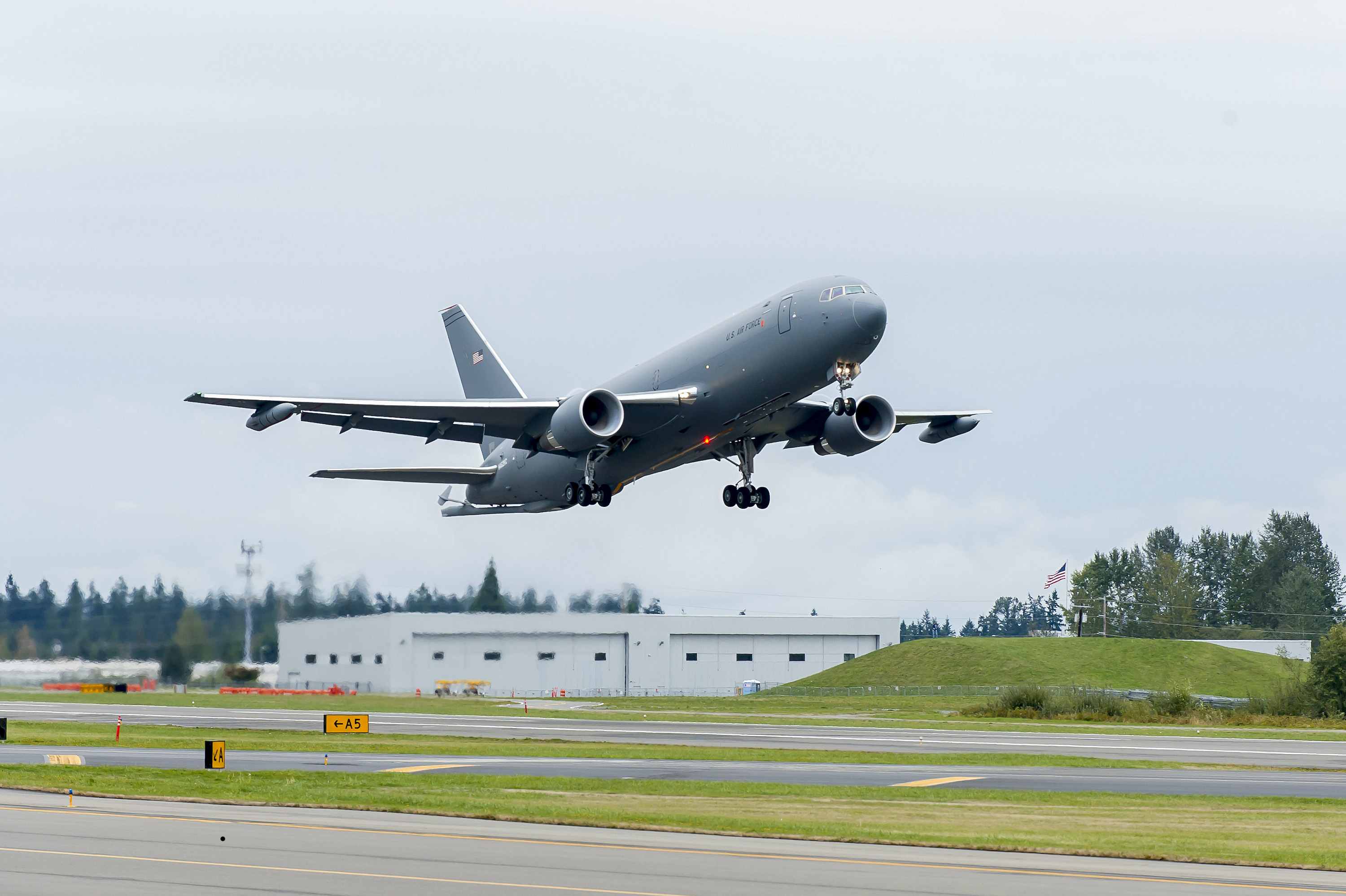 波音公司制造的KC-46A Pegasus加油机从华盛顿州埃弗雷特潘恩机场首飞。KC-46A是一种多用途加油机,能够与所有盟军与国际联军的飞机相兼容并为其空中加油,同时还能够运输乘客、物资与伤病员转运。
波音公司制造的KC-46A Pegasus加油机从华盛顿州埃弗雷特潘恩机场首飞。KC-46A是一种多用途加油机,能够与所有盟军与国际联军的飞机相兼容并为其空中加油,同时还能够运输乘客、物资与伤病员转运。 KC-46A Pegasus加油机完成首飞后在西雅图在波音机场着陆。
KC-46A Pegasus加油机完成首飞后在西雅图在波音机场着陆。 波音公司将对首飞后的KC-46A进行全面检查及仪器校准工作,并为接下来的一系统飞行进行准备,同时飞桁及机翼空中加油吊舱系统将被安装。
波音公司将对首飞后的KC-46A进行全面检查及仪器校准工作,并为接下来的一系统飞行进行准备,同时飞桁及机翼空中加油吊舱系统将被安装。
今年九月底,由波音公司与美国空军合作研发的KC-46A Pegasus空中加油机成功完成4小时的首飞任务,飞机从佩因机场起飞,降落在西雅图的波音研发中心。在此次飞行之前,该项目的首架飞机767-2C从2014年12月开始首飞,至今已完成了150小时以上的飞行测试。
在刚刚完成的这次飞行中,波音的测试飞行员检查了发动机、飞行控制系统与环境系统的运行情况,并将飞机带至最高飞行高度3.5万英尺。KC-46A配备两台 Pratt & Whitney发动机,推进力为65,000 lb,计划用于代替美国空军KC-135 Stratotankers加油机。
“现在,我们开始进行自由飞行稳定性测试,以及飞桁与机翼空中加油吊舱(WARP)的飞行控制测试。之后KC-46将完成空中加油测试,并与其他军用飞机进行联络,”美国空军KC-46系统项目总监Col. Christopher Coombs表示。
波音公司KC-46空中加油机副总裁兼项目经理Tim Peters表示,“预计今年晚些时候”可开展C节点测试。C节点测试意味着权威机构将评估一个项目是否达到了“工程与生产开发阶段”的完成要求,并准备好进入“生产与部署阶段”。
与此同时,波音还将在进入下一系列的飞行任务之前开展飞行后检验与仪器校准,在此期间对加油机的飞桁与WARP系统进行部署。KC-46将于今年年底启动为美国空军的数架飞机进行空中加油的任务。这些飞行任务的结果,加上任务系统展示以及刚刚完成的地面货物处理测试结果,将共同决定项目是否成功通过2016年的C节点评估。
波音公司于2011年与美国空军签订了共同设计并研发下一代空中加油机的合同。为此,波音公司开发了4架测试机。两架配置成767-2C机型,另外两架则是KC-46。这两架KC-46将作为全配置加油机接受美国联邦航空局与军方的认证评估,而767-2C将在完成飞行测试后升级成KC-46A配置,并添加空中加油系统。
KC-46A的定位是多用途空中加油机,它不仅可以为符合国际空中加油协议的所有联盟军队的飞机加油,而且还能运载乘客、货物和病人。总之,波音计划在2017年前为美国空军建造179架KC-46加油机,目前正在努力于“要求资产到位日”之前完成生产目标——该节点要求在2017年8月之前部署完毕18架飞机及必要的配套设备,为作战需求提供支持。
作者:Jean L. Broge
来源:SAE《航空工程杂志》
翻译:SAE 上海办公室
KC-46A tanker completes its first flight
The Boeing and the U.S. Air Force team behind the development of the KC-46A Pegasus tanker completed its first flight near the end of September, a four-hour flight that began at Paine Field and culminated at Boeing Field in Seattle. The first flight follows ongoing flight tests of the program’s first aircraft, a 767-2C that completed more than 150 flight test hours since making its first flight in December 2014.
During the most recent flight, Boeing test pilots performed operational checks on engines, flight controls, and environmental systems and took the tanker, being developed to replace the USAF's fleet of KC-135 Stratotankers, to a maximum altitude of 35,000 ft. The tanker is powered by two Pratt & Whitney engines with 65,000 lb of thrust.
“We’ll now begin free air stability tests and flight controls of the boom and wing aerial refueling pods (WARPs) before conducting aerial refueling tests where the KC-46 will make contact with other military aircraft down the road,” said Col. Christopher Coombs, USAF KC-46 System Program Manager.
Tim Peters, Boeing KC-46 tanker Vice President and Program Manager, says the tanker program is on track to begin Milestone C testing "later this year." Milestone C is the point at which authorities determine whether a program has met all of its exit criteria of the Engineering & Manufacturing Development Phase and is ready to enter into the Production and Deployment Phase.
In the meantime, Boeing will conduct a post-flight inspection and calibrate instrumentation prior to the next series of flights, during which the tanker boom and WARPs systems will be deployed. Before the end of the year, the KC-46 will begin conducting aerial refueling flights with a number of U.S. Air Force aircraft. Those flights, along with the mission systems demonstrations and a recently completed ground cargo handling test, will support the planned Milestone C decision in 2016.
As part of a contract awarded in 2011 to design and develop the next-generation tanker, Boeing is building four test aircraft—two are currently configured as 767-2Cs and two KC-46A tankers. The KC-46s will fly as fully equipped tankers through the FAA and military certification process, while the 767-2Cs enter flight test prior to receiving their upgrade to the KC-46A configuration and the addition of their aerial refueling systems.
The KC-46A is being developed as a multirole tanker that can refuel all allied and coalition military aircraft compatible with international aerial refueling procedures and can carry passengers, cargo, and patients. Overall, Boeing plans to build 179 KC-46 aircraft by 2017 for the USAF and is keeping pace toward meeting the Required Assets Available date—a milestone requiring 18 aircraft and all necessary support equipment to be on the ramp, ready to support warfighter needs by the August 2017.
Author: Jean L. Broge
Source: SAE Aerospace Engineering Magazine
等级
打分
- 2分
- 4分
- 6分
- 8分
- 10分
平均分
